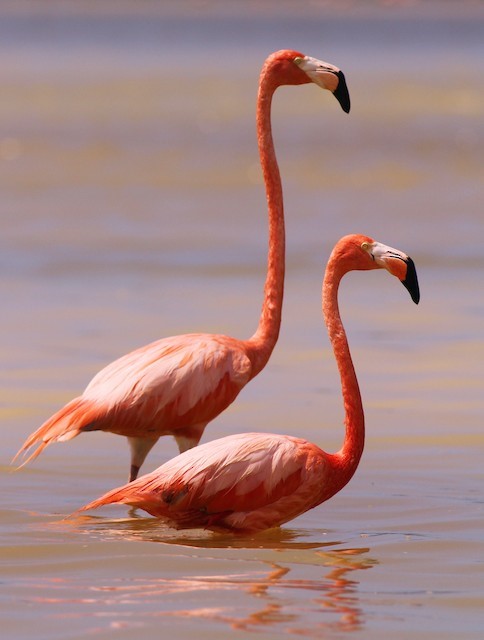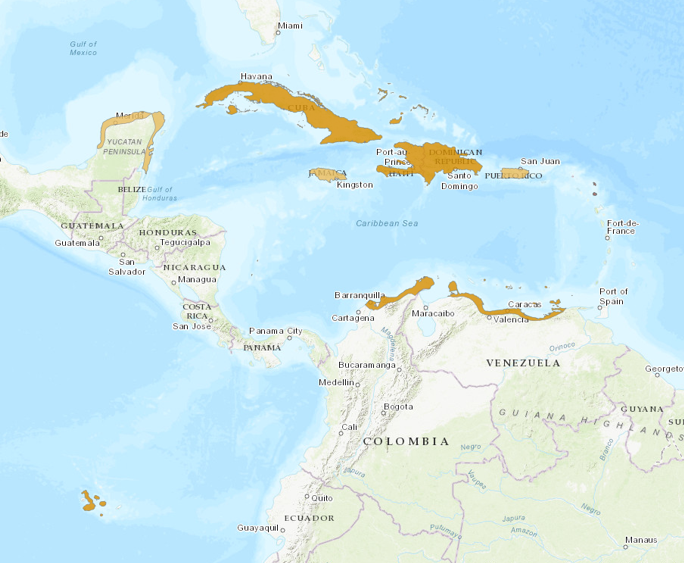Birdfinding.info ⇒ Locally common near its main breeding areas: in Mexico, at several sites along the Yucatán coast; in Cuba, at Las Salinas and Cayo Coco; on Great Inagua; in Venezuela, at Morrocoy National Park, Laguna de Unare, and Isla Margarita; and various sites in the Galápagos. Other areas where it can usually be found include: Turks & Caicos (nearly throughout); Laguna de Oviedo in the Dominican Republic; the Pekelmeer and Washington-Slagbai National Park on Bonaire; Salina St. Michiel on Curaçao; Los Flamencos Wildlife Refuge in Colombia; and the Caroni Swamp on Trinidad. In Florida, the most consistent site has been Snake Bight in Everglades National Park, but sightings there are sporadic. It is likely more continuously present in some less accessible areas of Florida Bay and the Everglades (see Status of the American Flamingo in Florida in the Notes below).
American Flamingo
Phoenicopterus ruber
Mainly along coasts of the Caribbean region and in lakes of the Galápagos Islands, but partly nomadic and irruptive beyond its regular range. Historically more widespread and in recent decades its populations have rebounded and returned to some areas where it was extirpated, especially along the northern coast of South America.
Breeding. Breeds colonially on expansive mudflats and salt pans, and in some cases on rocky islands. Its main breeding areas are: the northern Yucatán Peninsula; Cuba (mainly around Cayo Coco and the Zapata Swamp); Great Inagua; coastal Venezuela and Isla Margarita; and the Galápagos (Floreana, Isabela, Santiago, and Santa Cruz islands).
Several areas support smaller or sporadic populations, including: southern Florida; Andros; the south-central Bahamas (Long Island, Crooked Island, and Acklins); Turks & Caicos; Hispaniola (mainly the southwestern Dominican Republic); the ABC Islands (mainly on Bonaire, increasingly also on Curaçao, but rare on Aruba); the Guajira Peninsula of Colombia; Trinidad; coastal Surinam; and Amapá in northern Brazil. There is also a small reintroduced population on Anegada in the British Virgin Islands.
Its historical range covered more of the West Indies and extended east along the coast of South America to Rio Grande do Norte, Brazil. Many populations were heavily persecuted for their feathers and meat, and ultimately died out or relocated. Areas where it formerly bred but is now only an infrequent visitor include Jamaica, Puerto Rico, the Lesser Antilles, and Ilha de Marajó (at the mouth of the Amazon).
Movements. Nonbreeders disperse across a wider portion of the Caribbean Basin, both to established feeding areas and unpredictably elsewhere. A highly social species, it often wanders in flocks, which can be of any size from twos and threes up into the hundreds. When the local conditions are suitable, flocks sometimes linger for years and may form new colonies.
Its nomadic tendency often leads to long-distance vagrancy: throughout the Caribbean and coastal Gulf of Mexico, with exceptional records north to Kansas, Michigan, Ontario, Quebec, New Brunswick, Nova Scotia, and Bermuda, south into the interiors of Colombia and Venezuela, and east to Rio Grande do Norte. There have been many cases of lone individuals that remain in the same area for weeks, months, or years—apparently waiting for others to join them—and such cases are often well documented because the species is conspicuous and easily recognizable.
Identification
Usually the only flamingo in its range, though other species sometimes escape from captive flocks.
Adults are predominantly pink, in varying shades that range from whitish to scarlet.
The flight feathers are all-black, but are not usually visible when the wings are folded.

American Flamingo. (Celestún, Yucatán, Mexico; March 28, 2019.) © Mark Greene
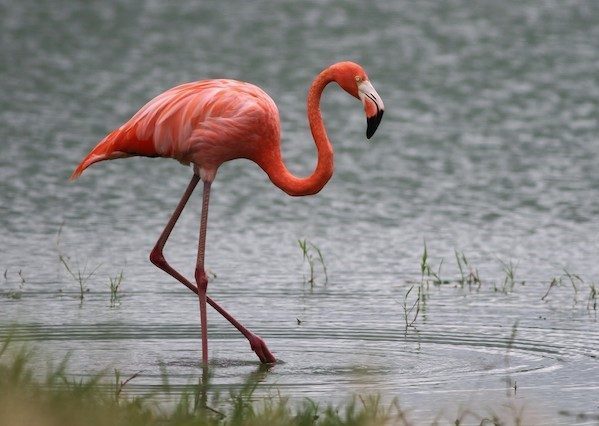
American Flamingo, with deep pink plumage and showing tricolored bill. (Camuy, Puerto Rico; March 22, 2017.) © Alex Lamoreaux
The legs are adull, pale pink and usually have darker reddish-pink “knees,” the contrast discernible at close range.
The bill is usually tricolored: black-tipped, whitish at the base, and pink in between. But the shade of pink in the bill typically matches the shade of the plumage, so in paler individuals, the bill typically appears bicolored, whitish and black.

American Flamingo, showing pale pink legs with darker knees—note that the bill appears bicolored. (Progreso, Yucatán, Mexico; May 24, 2019.) © Janet Guardiola
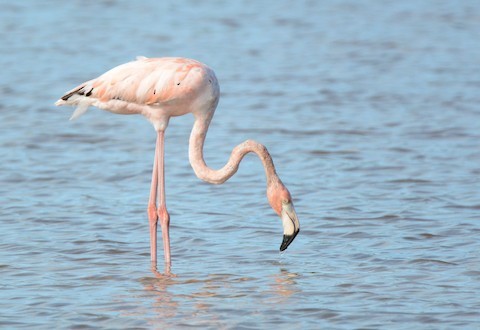
American Flamingo, a whitish adult showing pale pink legs with little contrast—note that the bill appears bicolored. (Rancho San Salvador, Ría Lagartos Biosphere Reserve, Yucatán, Mexico; December 3, 2017.) © Kyle Kittelberger
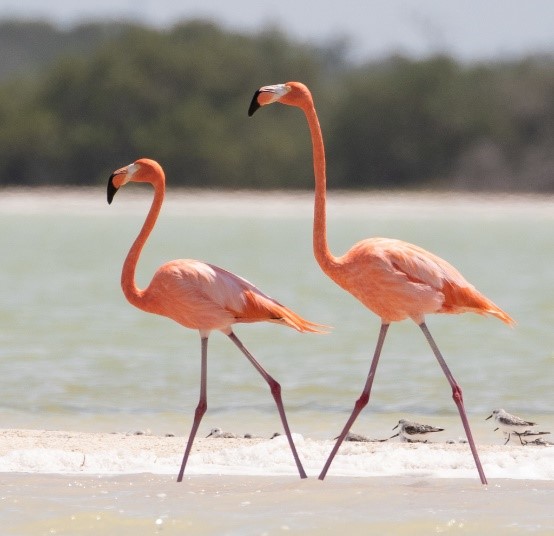
American Flamingo, showing pale pink legs with contrastingly darker, reddish-pink knees. (Ría Lagartos, Yucatán, Mexico; April 1, 2019.) © Fitz
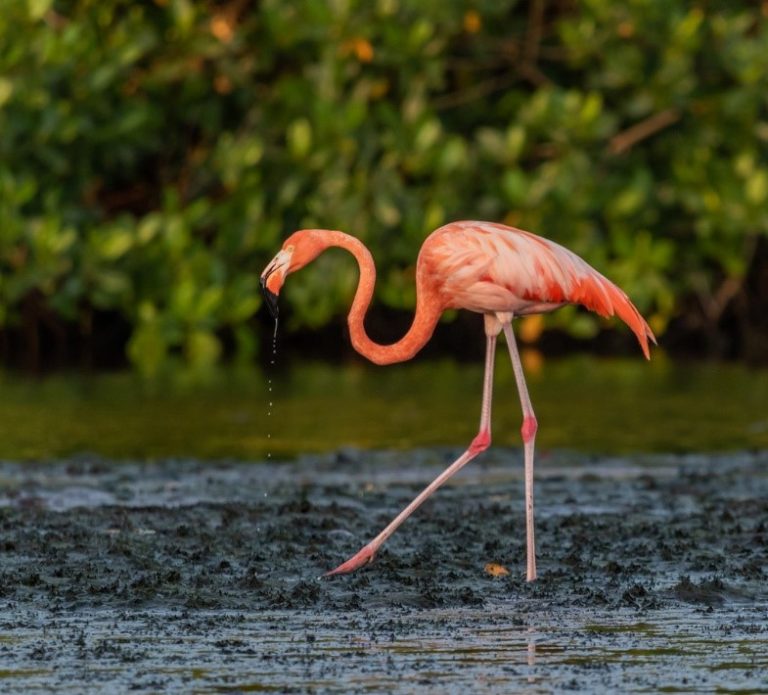
American Flamingo, showing pale pink legs with contrastingly darker, reddish-pink knees. (Caroni Swamp, Trinidad; December 18, 2018.) © Nancy Norman

American Flamingo, showing black flight feathers. (Garden Key, Dry Tortugas National Park, Florida; May 9, 2018.) © Suzanne Zuckerman
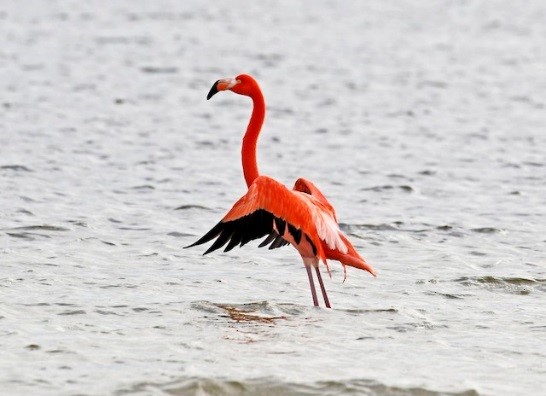
American Flamingo, showing scarlet plumage. (San Carlos Bay – Bunche Beach Preserve, Lee County, Florida; January 21, 2016.) © Tammy McQuade
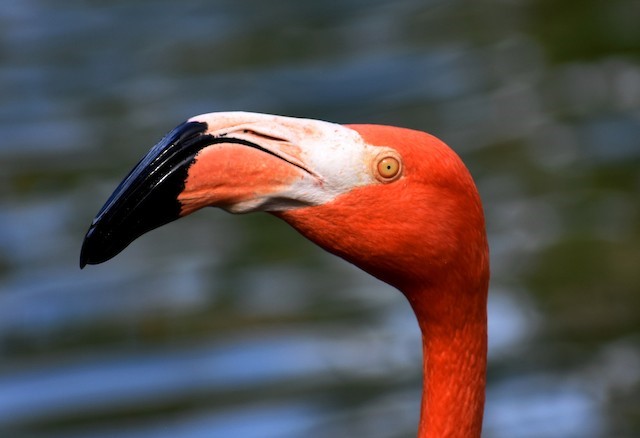
American Flamingo, showing bill coloration in detail. (Blau Natura Park, Punta Cana, Dominican Republic; March 31, 2018.) © Douglas Long

American Flamingo, wading in deep water, showing deep pink plumage. (Bonaire; July 21, 2019.) © bpenati
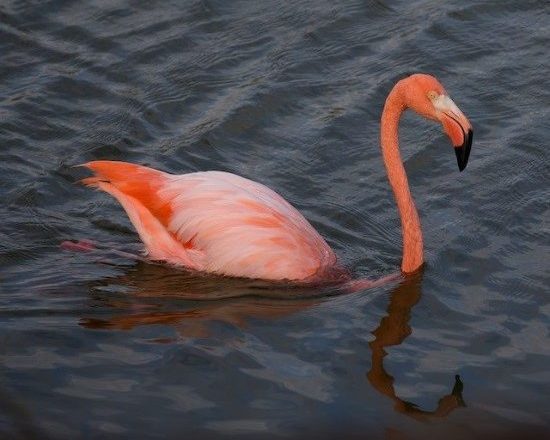
American Flamingo, swimming like a pink swan. (Punta Moreno, Isabela, Galápagos, Ecuador; July 19, 2015.) © Meg Barron
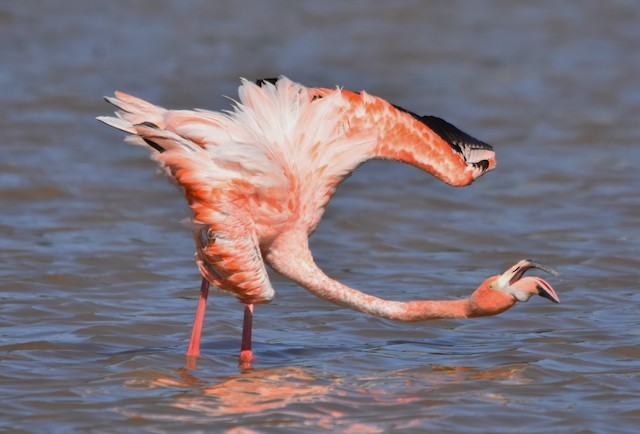
American Flamingo, trumpeting. (Grand Turk, Turks & Caicos; December 7, 2015.) © Keith Gregoire
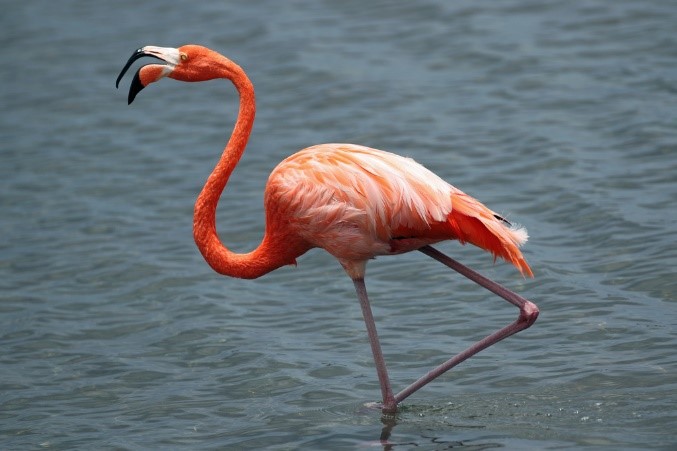
American Flamingo, with deep pink plumage and showing tricolored bill—note that the legs appear entirely pale pink, including the knees. (Rincón, Bonaire; April 8, 2017.) © Robin Gwen Argawal
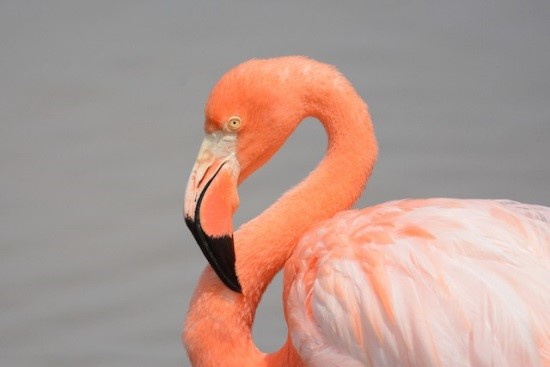
American Flamingo, showing color match between pink in bill and plumage. (Poza Puerta del Jelí, Isabela, Galápagos, Ecuador; June 5, 2015.) © Taylor Abbott

American Flamingo, showing its webbed feet. (Puerto Villamil, Isabela, Galápagos, Ecuador; January 28, 2015.) © Richard Read
Juveniles are ashy-gray overall, darkest on the head and neck, and become mostly white as they molt. Subadults progress gradually from gray to pink.
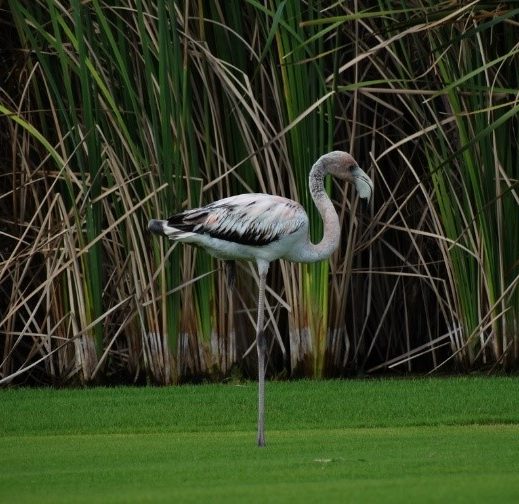
American Flamingo, subadult. (Cancún, Quintana Roo, Mexico; January 17, 2014.) © Alex Pacheco
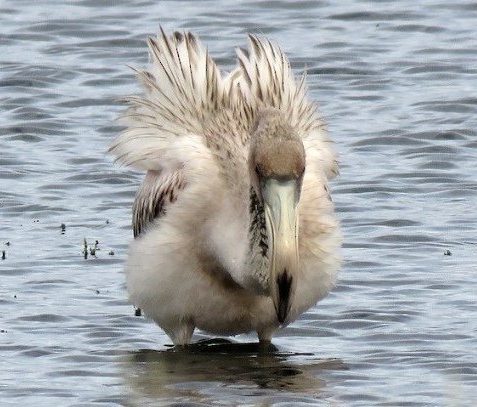
American Flamingo, juvenile. (Sasaki Seasonal Pond, Aruba; April 21, 2018.) © Glenda Tromp

American Flamingo, subadult. (Elizabeth Bay, Isabela, Galápagos, Ecuador; February 24, 2007.) © Nancy Cox
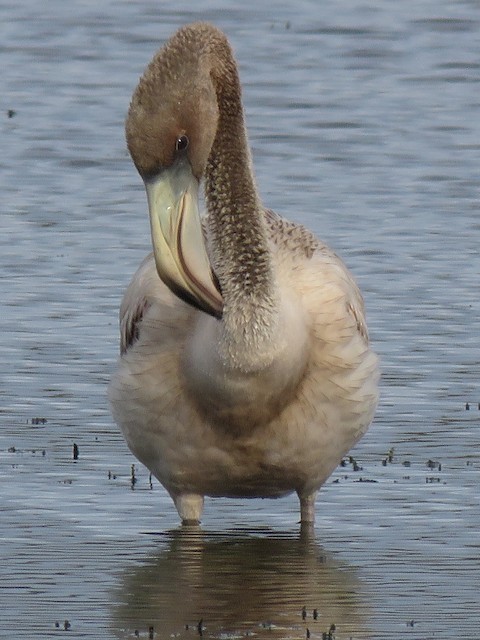
American Flamingo, juvenile. (Sasaki Seasonal Pond, Aruba; April 21, 2018.) © Glenda Tromp
The flight profile of all flamingos is distinctive at long range, as they fully extend their tremendously long, thin necks and legs.

American Flamingo, showing black flight feathers. (Yucatán, Mexico; February 21, 2011.) © Paul van Giersbergen
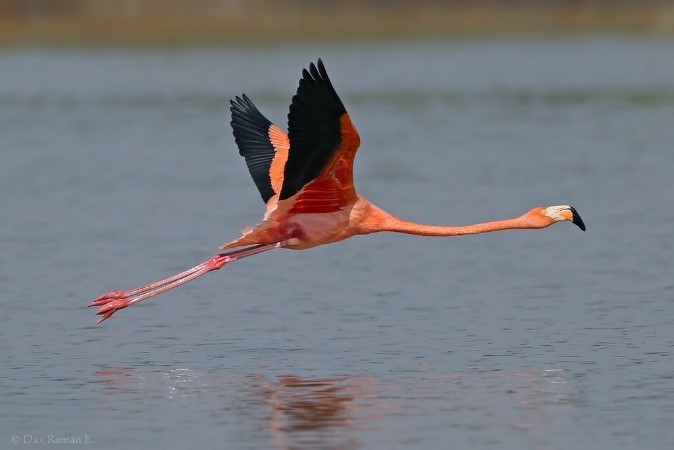
American Flamingo, subadult in flight. (Salinas de Baní, Dominican Republic; September 8, 2013.) © Dax M. Román E.
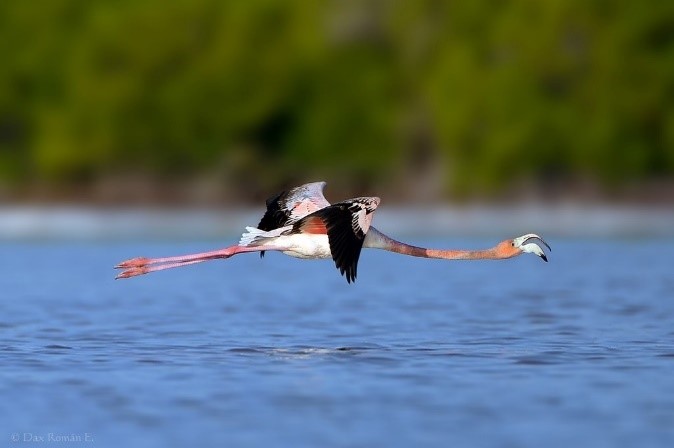
American Flamingo, subadult in flight. (Salinas de Baní, Dominican Republic; September 8, 2013.) © Dax M. Román E.
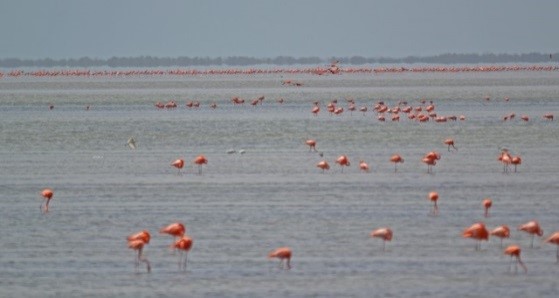
American Flamingo, as often seen, a pink band on the horizon. (Cayo Coco, Cuba; April 20, 2017.) © Michael J. Good

American Flamingo. (Ría Celestún, Yucatán, Mexico; November 26, 2017.) © Cory Gregory
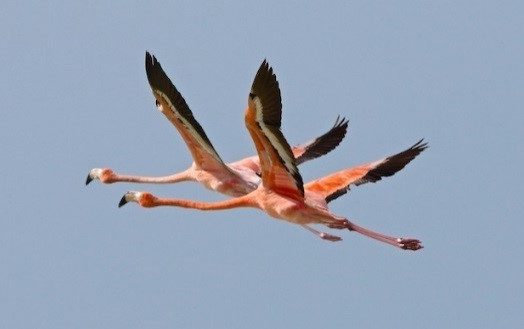
American Flamingos, showing white stripes on the underwings during molt. (North Andros, Bahamas; November 29, 2016.) © Harold Brewer
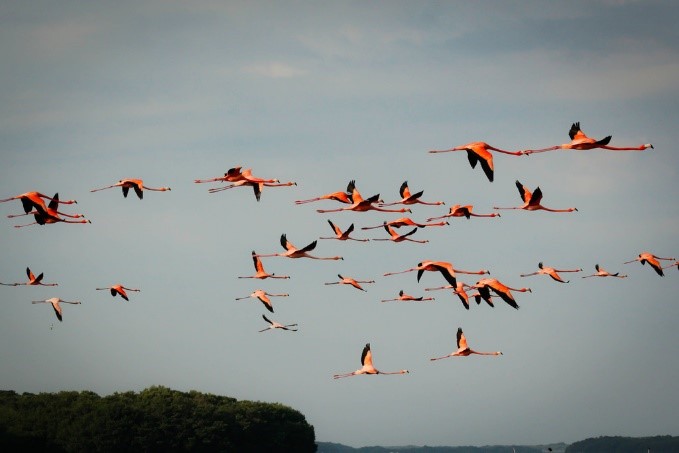
American Flamingo, flock in flight. (Celestún, Yucatán, Mexico; March 22, 2015.) © César Hernández Hernández
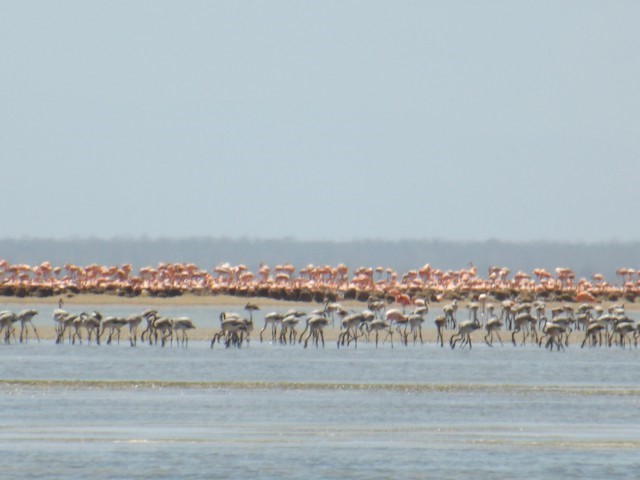
American Flamingo, adults in the background, juveniles in the foreground. (Ciénaga Los Olivitos, Zulia, Venezuela; April 8, 2018.) © Lermith Torres
Cf. Chilean Flamingo. Although their ranges do not overlap, American and Chilean Flamingos may sometimes occur in the same areas as both species tend to wander and are widely kept in captivity. Chilean is mostly pale pink, with deep reddish-pink wing coverts (and mostly black flight feathers, as in American). Its bill is bicolored, with the outer half black and the inner half pale pink, not tricolored. The black on its bill is more extensive than American’s. Most diagnostically, Chilean’s legs are pale gray with deep red “knees”—whereas American’s are pale pink with darker, reddish-pink “knees.” Chilean is also somewhat smaller than American, with shorter legs, although this difference would not be noticeable without a direct comparison.
Cf. Greater Flamingo. Greater and American were long considered conspecific. They are unlikely to come into contact except by human introduction. Greater’s overall coloration is like Chilean’s: mostly pale pink, with deep reddish-pink wing coverts (and mostly black flight feathers, as in both Chilean and American). Greater’s bill is bicolored: pale pink with a black tip. The black on its bill is less extensive than on American. Greater’s legs are entirely pale pink.
Notes
Monotypic species. Formerly considered conspecific with Greater Flamingo of the Old World.
Status of the American Flamingo in Florida.
Southern Florida is at the northern edge of the American Flamingo’s natural range, but its status there has been unclear until recently. It is most reliably seen in the northern shallows and flats of Florida Bay at Snake Bight in Everglades National Park, where small flocks are present sporadically in all seasons. Flocks also occur at least irregularly, and perhaps regularly, in remote areas of Florida Bay, the lower Keys, the Everglades (north to western Palm Beach County), and along the wild southwestern coast between Everglades City and Cape Sable. Individuals sometimes wander farther north along both coasts
Naturalists that visited Florida in the 1800s found large flocks of American Flamingo in many of the same areas: along the southwest coast, in Florida Bay, and on the Keys. There is anecdotal and egg specimen evidence of nesting in the lower Keys (specifically Sugarloaf Key and perhaps others). Large-scale persecution for feathers and meat caused the population to crash, and it became rare soon after 1900.
Small numbers of American Flamingos appeared sporadically in Florida throughout the 1900s, with the majority reported in and around Florida Bay—especially at Snake Bight. These birds originated from at least three sources: some, at least early in the century, were remnants of the decimated native population; some were escapees from captive flocks (in particular from the flock maintained at Hialeah Park in Miami); and some arrived through dispersal from colonies outside the U.S., as was long suspected and eventually proven by leg bands (on two individuals that hatched at different colonies on the Yucatán Peninsula).
In the 1990s, the frequency of sightings in Florida increased sharply. More significantly, the size of the flocks increased, with a flock of 65 found in 2003, and a startlingly large group of 147 found in 2014 along Highway 27 in Palm Beach County. The increase in Florida numbers corresponds to a broad increase in Mexican and Cuban breeding populations, and geographic expansion elsewhere, which suggests that natural dispersal from the south is at least a major factor—if not the main factor—driving the increase seen in southern Florida.
References
Alderfer, J., and J.L. Dunn. 2014. National Geographic Complete Birds of North America (Second Edition). National Geographic Society, Washington, D.C.
Ascanio, D., G.A. Rodriguez, and R. Restall. 2017. Birds of Venezuela. Christopher Helm, London.
BirdLife International. 2018. Phoenicopterus ruber. The IUCN Red List of Threatened Species 2018: e.T22729706A132180192. http://dx.doi.org/10.2305/IUCN.UK.2018-2.RLTS.T22729706A132180192.en. (Accessed September 19, 2019.)
del Hoyo, J., P. Boesman, and E.F.J. Garcia. 2019. American Flamingo (Phoenicopterus ruber). In Handbook of the Birds of the World Alive (J. del Hoyo, A. Elliott, J. Sargatal, D.A. Christie, and E. de Juana, eds.). Lynx Edicions, Barcelona. https://www.hbw.com/node/52785. (Accessed September 19, 2019.)
eBird. 2019. eBird: An online database of bird distribution and abundance. Cornell Lab of Ornithology, Ithaca, N.Y. http://www.ebird.org. (Accessed September 19, 2019.)
ffrench, R. 2012. A Guide to the Birds of Trinidad & Tobago (Third Edition). Cornell University Press. Ithaca, N.Y.
Garrido, O.H, and A. Kirkconnell. 2000. Field Guide to the Birds of Cuba. Cornell University Press, Ithaca, N.Y.
Haynes-Sutton, A., A. Downer, R. Sutton, and Y.-J. Rey-Millet. 2009. A Photographic Guide to the Birds of Jamaica. Princeton University Press, Princeton, N.J.
Howell, S.N.G., and S. Webb. 1995. A Guide to the Birds of Mexico and Northern Central America. Oxford University Press, Oxford.
Latta, S., C. Rimmer, A. Keith, J. Wiley, H. Raffaele, K. McFarland, and E. Fernandez. 2006. Birds of the Dominican Republic and Haiti. Princeton University Press, Princeton, N.J.
McMullan, M., and T. Donegan. 2014. Field Guide to the Birds of Colombia (Second Edition). Fundación Proaves de Colombia. Bogotá.
Raffaele, H., J. Wiley, O. Garrido, A. Keith, and J. Raffaele. 1998. A Guide to the Birds of the West Indies. Princeton University Press, Princeton, N.J.
Staletovich, J. 2018. Is century-old Florida flamingo mystery finally solved? Scientists say yes. Miami Herald (Feb. 21, 2018). https://www.miamiherald.com/news/local/environment/article201275359.html.
van Perlo, B. 2009. A Field Guide to the Birds of Brazil. Oxford University Press, Oxford.
Wells, J.V., and A.C. Wells. 2017. Birds of Aruba, Bonaire, and Curaçao. Cornell University Press, Ithaca, N.Y.
Whitfield, S.M., P. Frezza, F.N. Ridgley, A. Mauro, J.M. Patterson, A. Pernas, and J.J. Lorenz. 2018. Status and trends of American Flamingos (Phoenicopterus ruber) in Florida, USA. Condor 120:291-304.
WikiAves, Flamingo, http://www.wikiaves.com.br/flamingo.
